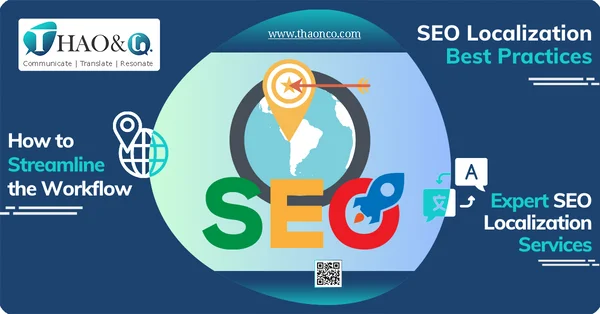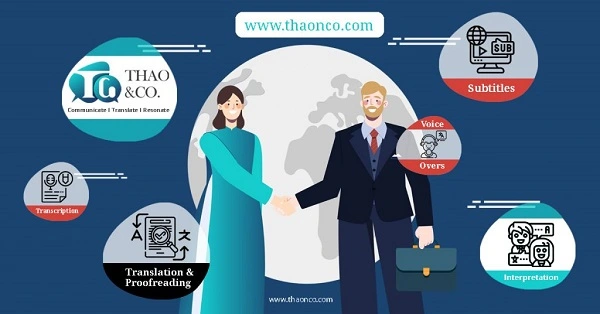Did you know that only around 20% of the world population speak English, even though it’s the most spoken language? Yet too many businesses fail to translate and localize their valuable content. With the Internet connecting over 5.3 billion people worldwide, the time for SEO localization is now.
Don’t let content gaps undermine your global success and miss out on international audiences. In this comprehensive guide, Thao & Co. walks you through the steps to leverage SEO localization to reach international searchers and convert them into loyal customers.
Search engine optimization (SEO) is crucial for driving relevant organic traffic to your website as well as building online brand visibility. Think of it as the magic key that unlocks doors, letting the world know that your products exist, and making it easier for potential customers to find you.
SEO works by optimizing your website’s content and structure to climb the ranks of search engine results. When someone searches for keywords related to your offerings, your website appears, catching their eyes and inviting them in.
But what happens when you want to expand your marketplace beyond your own borders? That’s when SEO localization comes in.
SEO localization refers to adapting your content for specific target languages and regions to boost international visibility and conversion rates. It goes far beyond basic translation to carefully tailor messaging, site architecture, and other search engine optimization elements to resonate with local cultures and ranking algorithms.

The benefits of investing in SEO localization include:
However, successful SEO localization involves overcoming considerable challenges:
At its core, SEO localization is about understanding that adapting your content for overseas markets requires more than just converting text between languages.
Translation involves the direct conversion of content from the original language to one or more target languages without deeper cultural adaptation. Accurate translation can be achieved with translators possessing industry expertise which allows them to faithfully convey technical terminology.
On the other hand, localization refers to the comprehensive process of adjusting content about products and services to align closely with the linguistic, cultural, and market preferences.
This helps your products or services make meaningful connections with your target audiences across barriers such as languages, behaviors, currencies, measurement formats, legal compliance needs, among others.
A lot of effort goes into tailoring and testing localized content, ensuring that it truly resonates with global target audiences. This level of alignment with the target culture and search patterns drives better international SEO performance.
Conducting specialized multilingual keyword research is vital for connecting with local searchers. Unfortunately, simply translating keywords doesn’t always accurately capture unique local searcher intent and behavior.
Each language has its own nuances, cultural references, and contextual meanings. Relying solely on translation tools often fails to adapt keywords for relevancy in every market.
For instance, the English keyword “real estate” translates to “bienes raíces” in Spanish, but region-specific variations such as “propiedades” may be more popular in some Hispanic countries.
Language complexities also vary, creating challenges with expansion to longer-tail, multi-word keywords. Additionally, keyword popularity and search volume differ significantly across regions. Targeting English keywords in foreign markets without research is essentially shooting in the dark.
Advanced multilingual keyword research is the key to unlocking SEO localization success. This requires using high-quality tools providing extensive data analysis and native linguist review.
Such tools provide actionable localized keyword recommendations with validated search volume data, allowing you to accurately target keywords tailored to each language and location.
Comprehensive multilingual keyword research minimizes guesswork by confirming keywords that match local search behavior. It also surfaces hidden “long-tail” gems that may be overlooked when directly translating keywords.
If you want a deeper dive into multilingual keyword targeting, check out Thao & Co.’s in-depth guide on optimizing keyword research for multiple languages.
This guide will help you effectively attract high-intent traffic that converts rather than relying on generic and potentially inaccurate keywords.

An effective localization strategy goes beyond one-off content translation – it involves planning translated content in content pillars, clusters, and buyer journeys.
You can start by auditing existing assets and identify content categories that perform well globally. These categories are your content pillars to localize as a priority. With each pillar, develop localized content clusters, meaning groups of thematically related, complementary content.
This approach helps you strategically target topics within broader subjects in a structured way. For example, the “SEO” pillar may contain clusters such as “keyword research,” “technical optimization,” “content creation.” etc. in every language.
It’s also important to map translated content to local buyer journeys. Buyer psychology can vary across regions, so ensure that your content matches regional behavior during awareness, consideration, and decision stages.
As you build your clusters, you can translate evergreen and pillar content first before expanding to seasonal or promotional content. Start with product guides, blogs, and FAQs as they attract search traffic year-round.
Long-form assets such as eBooks should be balanced with shorter snackable content. Also, keep in mind that differ platforms call for different formats and lengths.
Still unsure? Take a look at Thao & Co,’s playbook on SEO content planning. In this comprehensive guide, we dive into all aspects of multilingual content planning in detail.
Successful SEO localization starts with writing high-impact content that both follows SEO best practices and can be localized efficiently. If you intend to localize your content into different languages, here’s what you should consider during the creation of your original content:
When including images in your content, consider using graphics that minimize or fully exclude text, allowing for easy adaptation across languages and regions. For example:
These context-free visuals fit seamlessly into the newly localized content without editing requirements. Readers can understand such purely visual information consistently across cultures.
On the other hand, images that rely on embedded text require extensive localization efforts. Those include:
Since text embedded in images can’t be directly edited without the design files, sometimes, the graphics must be completely recreated in each language. Most of the time, the value provided by these text embedded images isn’t significant enough to justify the added design workload.
For an extensive guide on writing SEO content that is optimized for search engines and easy adaptation, see Thao & Co.’s ultimate guide to SEO content.

To scale your translated content production efficiently, it’s important to manage your localization process well. Based on our localization experience at Thao & Co., there are 3 key areas that should be optimize:
It goes without saying, a skilled team of translators and editors ensures your localization accuracy and quality:
When selecting a localization partner, always evaluate their prior products, their quality assurance methods, and communication responsiveness.
Your localization partner’s technological capabilities are crucial for seamless collaboration and content adaptation at scale. Seek providers who leverage a centralized content creation and translation management system that offers:
For successful SEO localization, quality assurance begins even before your content is created. It requires:
By combining upfront planning, linguistic talent, and layered review process, you get not only accurate but also culturally resonating content. High-quality localization makes it feel like your content is made just for your target audiences.

As a professional translation and localization company, Thao & Co. leverages our own proprietary platform to efficiently manage and produce localized content at scale.
With extensive experience in executing international SEO localization campaigns, we help brands adapt their content for international audiences. Our flexible B2B localization workflow enables us to deliver large-scale projects for diverse industry leaders:
Our comprehensive content creation and localization suite of services helps you extend your digital presence globally and unlock international revenue streams.
Connect with Thao & Co.’s experts today to kick start your SEO localization project – increase your international website traffic and conversion rates with locale-tailored content strategy and impactful localization.